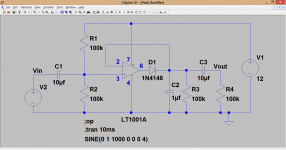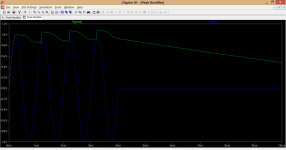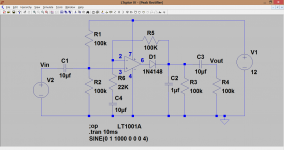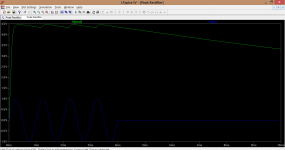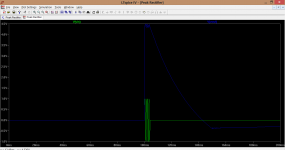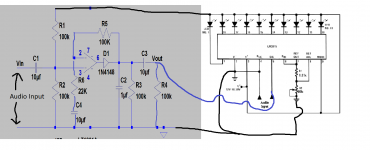I think you are misunderstanding  Using the variable resistor will allow you to see/test/check that the LED's light correctly and allow you to set the brightness using the method outlined earlier.
Using the variable resistor will allow you to see/test/check that the LED's light correctly and allow you to set the brightness using the method outlined earlier.
To get the meter to work properly with audio requires the rectifier and peak hold we mentioned before. There is no escaping that... its a must.
To get the meter to work properly with audio requires the rectifier and peak hold we mentioned before. There is no escaping that... its a must.
Try and follow what happens...
the audio signal is a constantly varying quantity. It goes both "above and below" the 0 volt or ground point on your circuit. The audio is rapidly moving and full of transients... they are peaks in the signal that last for a very short time.
The rectifier (an ideal theoretical one) would remove the negative part of the signal and leave just the positive parts of the signal. That in itself isn't enough because the peaks last for such a short time that they do not illuminate the LED's enough to notice. So we need to provide an input voltage that follows the audio but as more of an average level of its volume. To do that we need a diode (an imperfect rectifier) and some form of active amplifier (to try and make the rectifier more perfect in operation). We then add a capacitor to slow things down and allow the signal to average out. That is the signal you need to apply to your LM3915.
You can't escape from that... its an essential.
the audio signal is a constantly varying quantity. It goes both "above and below" the 0 volt or ground point on your circuit. The audio is rapidly moving and full of transients... they are peaks in the signal that last for a very short time.
The rectifier (an ideal theoretical one) would remove the negative part of the signal and leave just the positive parts of the signal. That in itself isn't enough because the peaks last for such a short time that they do not illuminate the LED's enough to notice. So we need to provide an input voltage that follows the audio but as more of an average level of its volume. To do that we need a diode (an imperfect rectifier) and some form of active amplifier (to try and make the rectifier more perfect in operation). We then add a capacitor to slow things down and allow the signal to average out. That is the signal you need to apply to your LM3915.
You can't escape from that... its an essential.
Look at this. You need the first opamp (any opamp such as a 741), the second can be omitted. If you want to attempt this then notice that the opamp uses a negative as well as positive rail... we can show you what to do if you want to build something like this.
> inside circuits > low drift peak detector l9755 - Next.gr
> inside circuits > low drift peak detector l9755 - Next.gr
This is what you need. The opamp can be any common type, a 741 or TL071 would be ideal. In order for the device to work correctly on a "single rail" supply we need R1 and R2 to bias the opamp to one half the rail voltage. These resistor can be any value in the 10k to 220k range as long as both are equal. The audio comes in at the left via the coupling cap C1 (positive end of cap to the opamp for all the caps in these circuits). The diode can be any silicon diode such as a 1N4148. C2 and R3 set the time constant... how long the circuit holds on to the peak voltages. You can experiment with the value of these. The voltage output is AC coupled to the LM3915 via C3. The output is tied or referenced to ground via R4.
The waveforms show the input signal of just four cycles of a 1kHz sine wave. The green trace shows the voltage at the output. This is what you will apply to the LM3915. Notice how slowly it falls. This means the LED's stay on for longer which is what you want.
The circuit can altered to give gain by the addition of two resistors and a cap. The approximate gain is given by (R5+R6)/R6 and so we have a gain of 5.5. Notice the amplitude of the output signal now.
The final image shows it better. Four cycles of the input signal appearing in isolation. Look at the output voltage.
The waveforms show the input signal of just four cycles of a 1kHz sine wave. The green trace shows the voltage at the output. This is what you will apply to the LM3915. Notice how slowly it falls. This means the LED's stay on for longer which is what you want.
The circuit can altered to give gain by the addition of two resistors and a cap. The approximate gain is given by (R5+R6)/R6 and so we have a gain of 5.5. Notice the amplitude of the output signal now.
The final image shows it better. Four cycles of the input signal appearing in isolation. Look at the output voltage.
Attachments
Yo thanks for the help.But i got some questions.. So all this opamp will increase the voltage? I thought i need to increase the current flow not the voltage? And my 2 audio wires connects where shown V in? ground to negative and R or L to the positive? and what do i connect to the right side? Do i have to connect right side to positive and negative rails on my breadoard?
The opamp will increase the voltage if needed by means of the extra resistors as I showed above. You may or may not need that as it depends how much voltage your signal source puts out. Its voltage we need to drive the LM3915.
So the audio connects to Vin at the left. Pin 7 of the opamp goes to main supply feeding the 3915. What are you running it on ? You need at least 9 volts. The output at the right goes to the input pin of the 3915 with the ground being a common throughout.
So the audio connects to Vin at the left. Pin 7 of the opamp goes to main supply feeding the 3915. What are you running it on ? You need at least 9 volts. The output at the right goes to the input pin of the 3915 with the ground being a common throughout.
Mooly, you have the patience of a saint.
I'm not sure the OP knows what he is experimenting with, sometimes you have to go back to basics to understand what is going on. This in no way contradicts what has been said above but may offer an alternative view to the situation.
The LM3915 is a device that uses a voltage at its input to illuminate LEDs.
The higher the voltage the greater the number of LEDs that are illuminated.
LEDs are fairly quick but the human eye is very slow.
Flash an LED too quickly and you will not see it flash.
What you need is a slow average of the voltage, then you will see a progressive LED pattern on the display.
I'm not sure the OP knows what he is experimenting with, sometimes you have to go back to basics to understand what is going on. This in no way contradicts what has been said above but may offer an alternative view to the situation.
The LM3915 is a device that uses a voltage at its input to illuminate LEDs.
The higher the voltage the greater the number of LEDs that are illuminated.
LEDs are fairly quick but the human eye is very slow.
Flash an LED too quickly and you will not see it flash.
What you need is a slow average of the voltage, then you will see a progressive LED pattern on the display.
Mooly, you have the patience of a saint.
aggree. No one else survived my questions that long.. I know that i should try to do it by myself and stuff but believe me im so bad, most things i try to do by myself 99% i fail. The god didint give me enough brains and my logical thinking is also very very bad..
aggree. No one else survived my questions that long.. I know that i should try to do it by myself and stuff but believe me im so bad, most things i try to do by myself 99% i fail. The god didint give me enough brains and my logical thinking is also very very bad..
When you are starting out in any hobby you need to start slowly and build your knowledge using building blocks.
As Mooly stated very early on lets look at the LM3915 on it own.
Ignore the audio input, that will come later.
Connect a potentiometer (volume control) between Vcc (+15V) and GND (0V) and connect the wiper to the input of the LM3915, as you move the pot you will see the number of LEDs vary.
As Mooly stated very early on lets look at the LM3915 on it own.
Ignore the audio input, that will come later.
Connect a potentiometer (volume control) between Vcc (+15V) and GND (0V) and connect the wiper to the input of the LM3915, as you move the pot you will see the number of LEDs vary.
Mooly, you have the patience of a saint.
Thanks
Mooly, you have the patience of a saint.
aggree. No one else survived my questions that long.. I know that i should try to do it by myself and stuff but believe me im so bad, most things i try to do by myself 99% i fail. The god didint give me enough brains and my logical thinking is also very very bad..
All I'll say is that if its a subject that you are interested in and want to learn then you will
- Status
- This old topic is closed. If you want to reopen this topic, contact a moderator using the "Report Post" button.
- Home
- General Interest
- Everything Else
- lm 3915 vu meter problem.
